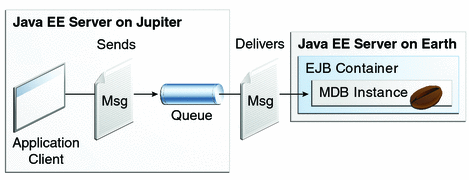Overview of the consumeremote Example Modules
Except for the fact that it is packaged as two separate modules, this example is very similar to the one in Chapter 17, A Message-Driven Bean Example:
-
One module contains the application client, which runs on the remote system and sends three messages to a queue.
-
The other module contains the message-driven bean, which is deployed on the local server and consumes the messages from the queue on the remote server.
-
The administrator starts two Java EE servers, one on each system.
-
On the local server, the administrator deploys the message-driven bean module, which specifies the remote server where the client is deployed.
-
On the remote server, the administrator places the client JAR file.
-
The client module sends three messages to a queue.
-
The message-driven bean consumes the messages.
The basic steps of the modules are as follows.
Figure 31–5 illustrates the structure of this application. You can see that it is almost identical to Figure 17–1 except that there are two Java EE servers. The queue used is the one on the remote server; the queue must also exist on the local server for resource injection to succeed.
Figure 31–5 A Java EE Application That Consumes Messages from a Remote Server

- © 2010, Oracle Corporation and/or its affiliates
